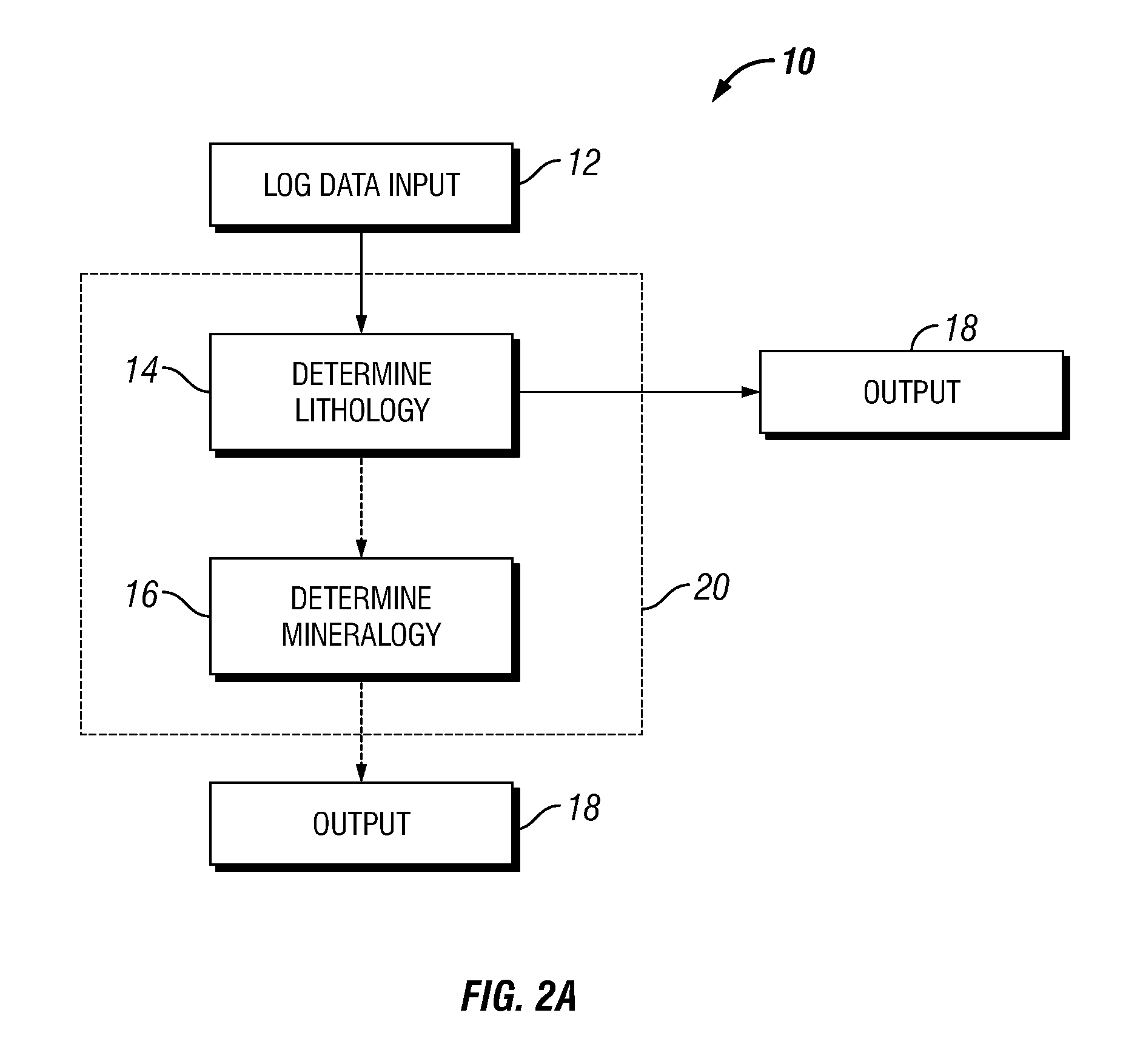Methods for quantitative lithological and mineralogical evaluation of subsurface formations
a technology of lithological and mineralogy, applied in the field of methods for determining the lithology and mineralogy of a subterranean formation, can solve the problems of ineffective exploration application, time-consuming traditional methods, and technique of seemingly limited utility
- Summary
- Abstract
- Description
- Claims
- Application Information
AI Technical Summary
Problems solved by technology
Method used
Image
Examples
example 1
Analysis of a Western Louisiana Well
[0100]To evaluate the quality and potential applications of the downhole lithology and mineralogy measurements to reservoir characterization, according to the methods of the present invention, geochemical well logs using the FLEX™ / Spectralog®wireline logging tool / sonde (Baker Atlas, Houston, Tex.) were obtained from a well in Western Louisiana. The results of the logs at a depth ranging from about 5050 feet to about 5400 feet below the surface, in comparison with core data analysis, are presented in the plots of FIG. 13.
[0101]As evidenced by the general lithology information presented in stratigraphic column A, the intervals in this well include carbonate, anhydrite, and some fairly clean sandstone at the lower depths. The large amounts of sulfur and calcium coupled with a lack of carbon provide clear indicators for the presence of anhydrite. As illustrated in stratigraphic column B, providing specific lithology information about the well, the car...
example 2
Analysis of a South American Well
[0102]To further evaluate the quality and potential applications of the downhole lithology and mineralogy measurement methods disclosed herein to reservoir characterization, geochemical well logs using the Formation Lithology Explorer (FLEX™) wireline logging tool (Baker Atlas, Houston, Tex.) and the Spectralog® II instrument to quantify gamma-rays from neutron capture and inelastic scattering, were run in a test well in South America. These results are presented graphically in the schematic stratigraphic columns of the formation illustrated in FIG. 14. As illustrated therein in stratigraphic column A, showing the general lithology of the test section, the test well has a significant carbonate section at the top of the interval, followed by an extremely clean sand zone below, intermixed with several shale zones at the lower depths. As illustrated in stratigraphic column B, providing specific lithology information about the test well, the carbonate is...
example 3
Analysis of a West Texas Well
[0104]In yet another example to further evaluate the quality and potential applications of the present downhole lithology and mineralogy measurement methods to reservoir characterization, geochemical well logs using a logging sonde to measure gamma rays from neutron capture and inelastic scattering were run in a test well in the Permian Basin of West Texas, which has been previously detailed petrographically by a number of individuals [see, for example, Saller, A. H., et al., AAPG Bulletin, v. 82(8): pp. 1528-1550 (1998), as well as references cited therein]. As illustrated in FIG. 15, the core mineralogy based on X-Ray Diffraction (XRD) displays an excellent agreement with the mineralogy as determined by the systems and methods of the present invention. Stratigraphic column A of FIG. 15, providing general lithology information of the test well between a depth of about 4900 feet (measured depth, MD) and about 5250 feet (MD), shows that the test well has ...
PUM
 Login to View More
Login to View More Abstract
Description
Claims
Application Information
 Login to View More
Login to View More - R&D
- Intellectual Property
- Life Sciences
- Materials
- Tech Scout
- Unparalleled Data Quality
- Higher Quality Content
- 60% Fewer Hallucinations
Browse by: Latest US Patents, China's latest patents, Technical Efficacy Thesaurus, Application Domain, Technology Topic, Popular Technical Reports.
© 2025 PatSnap. All rights reserved.Legal|Privacy policy|Modern Slavery Act Transparency Statement|Sitemap|About US| Contact US: help@patsnap.com



